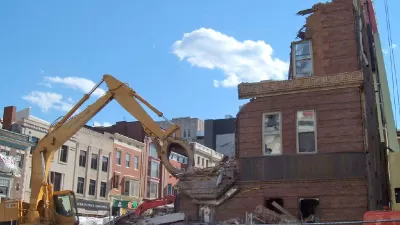The tussle over the historic designation of a property owned by a Chicago church exposes the conflicting agendas of politics, property rights, preservation, and constitutional law.
Faced with a recent reality check on repair costs for its rectory, a Chicago church is now crying foul over a seven-year-old Chicago ordinance that includes the traditional house of residence for its parish priest in a city landmark district.
The Chicago Landmarks Ordinance provides that: "No building that is owned by a religious organization and is used primarily as a place for the conduct of religious ceremonies shall be designated as a historical landmark without the consent of its owner." The church claims the rectory was used in the past for religious ceremonies such as prayer groups and inter-faith weddings, and that it did object at the time the landmark district was being considered.
The rectory is a contributing building to the Logan Square Boulevards district, and the neighborhood Logan Square Preservation group wants to keep the historically significant building in the district and fears that to do otherwise would set a precedent undermining historic preservation districts in general.
Given its setting, the national cliche of Chicago politics enters the debate including arguments about voting, graft and aldermanic privilege in addition to religious freedom, mission and practice (in the same neighborhood where the recent chicken war was flamed). The debate also intersects with a recent constitutional challenge to landmark designation.
Thanks to Lynn Stevens

Alabama: Trump Terminates Settlements for Black Communities Harmed By Raw Sewage
Trump deemed the landmark civil rights agreement “illegal DEI and environmental justice policy.”

Planetizen Federal Action Tracker
A weekly monitor of how Trump’s orders and actions are impacting planners and planning in America.

The 120 Year Old Tiny Home Villages That Sheltered San Francisco’s Earthquake Refugees
More than a century ago, San Francisco mobilized to house thousands of residents displaced by the 1906 earthquake. Could their strategy offer a model for the present?

In Both Crashes and Crime, Public Transportation is Far Safer than Driving
Contrary to popular assumptions, public transportation has far lower crash and crime rates than automobile travel. For safer communities, improve and encourage transit travel.

Report: Zoning Reforms Should Complement Nashville’s Ambitious Transit Plan
Without reform, restrictive zoning codes will limit the impact of the city’s planned transit expansion and could exclude some of the residents who depend on transit the most.

Judge Orders Release of Frozen IRA, IIJA Funding
The decision is a victory for environmental groups who charged that freezing funds for critical infrastructure and disaster response programs caused “real and irreparable harm” to communities.
Urban Design for Planners 1: Software Tools
This six-course series explores essential urban design concepts using open source software and equips planners with the tools they need to participate fully in the urban design process.
Planning for Universal Design
Learn the tools for implementing Universal Design in planning regulations.
Clanton & Associates, Inc.
Jessamine County Fiscal Court
Institute for Housing and Urban Development Studies (IHS)
City of Grandview
Harvard GSD Executive Education
Toledo-Lucas County Plan Commissions
Salt Lake City
NYU Wagner Graduate School of Public Service




























